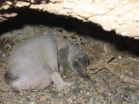(Press-News.org) ARLINGTON, Va. - Marking a milestone for the Navy, the Office of Naval Research and its industry partner on April 6 successfully tested a solid-state, high-energy laser (HEL) from a surface ship, which disabled a small target vessel.
The Navy and Northrop Grumman completed at-sea testing of the Maritime Laser Demonstrator (MLD), which validated the potential to provide advanced self-defense for surface ships and personnel by keeping small boat threats at a safe distance.
"The success of this high-energy laser test is a credit to the collaboration, cooperation and teaming of naval labs at Dahlgren, China Lake, Port Hueneme and Point Mugu, Calif.," said Chief of Naval Research Rear Adm. Nevin Carr. "ONR coordinated each of their unique capabilities into one cohesive effort."
The latest test occurred near San Nicholas Island, off the coast of Central California in the Pacific Ocean test range. The laser was mounted onto the deck of the Navy's self-defense test ship, former USS Paul Foster (DD 964).
Carr also recognized the Office of the Secretary of Defense's High Energy Joint Technology Office and the Army's Joint High Powered Solid State Laser (JHPSSL) program for their work. MLD leverages the Army's JHPSSL effort.
"This is the first time a HEL, at these power levels, has been put on a Navy ship, powered from that ship and used to defeat a target at-range in a maritime environment," said Peter Morrison, program officer for ONR's MLD.
In just slightly more than two-and-a-half years, the MLD has gone from contract award to demonstrating a Navy ship defensive capability, he said.
"We are learning a ton from this program-how to integrate and work with directed energy weapons," Morrison said. "All test results are extremely valuable regardless of the outcome."
Additionally, the Navy accomplished several other benchmarks, including integrating MLD with a ship's radar and navigation system and firing an electric laser weapon from a moving platform at-sea in a humid environment. Other tests of solid state lasers for the Navy have been conducted from land-based positions.
Having access to a HEL weapon will one day provide warfighter with options when encountering a small-boat threat, Morrison said.
But while April's MLD test proves the ability to use a scalable laser to thwart small vessels at range, the technology will not replace traditional weapon systems, Carr added.
"From a science and technology point of view, the marriage of directed energy and kinetic energy weapon systems opens up a new level of deterrence into scalable options for the commander. This test provides an important data point as we move toward putting directed energy on warships. There is still much work to do to make sure it's done safely and efficiently," the admiral said.
INFORMATION:
About the Office of Naval Research
The Department of the Navy's Office of Naval Research (ONR) provides the science and technology necessary to maintain the Navy and Marine Corps' technological advantage. Through its affiliates, ONR is a leader in science and technology with engagement in 50 states, 70 countries, 1,035 institutions of higher learning and 914 industry partners. ONR employs approximately 1,400 people, comprising uniformed, civilian and contract personnel, with additional employees at the Naval Research Lab in Washington, D.C.
Maritime laser demonstrator
MLD test moves Navy a step closer to lasers for ship self-defense
2011-04-09
ELSE PRESS RELEASES FROM THIS DATE:
Biologist Belovsky's paper offers new insights into predator/prey relationships
2011-04-09
For those old enough to remember Mutual of Omaha's "Wild Kingdom" television series, the dynamics of predator-prey relationships seemed clear enough: predators thinned out prey populations, which enabled a smaller, but stronger, population to survive and reproduce.
However, a new paper by University of Notre Dame biologist Gary Belovsky appearing in the prestigious journal Ecology Letters suggests that predator-prey relationships are much more complex than originally thought.
The paper arose out of pioneering studies Belovsky, who also is director of the Notre Dame ...
Cookies or careers?
2011-04-09
College Park, Md.—Nearly 5 million American children participate in the Boy Scouts and Girl Scouts, but until now no one has looked at the gender messages young people get when they start collecting those coveted badges.
Kathleen Denny, a sociology graduate student at the University of Maryland, College Park, analyzed scouting manuals and found that—despite positive aspects—today's scouts are being fed stereotypical ideas about femininity and masculinity. Her findings were recently published in Gender & Society, the highly-ranked journal of Sociologists for Women in Society.
Girl ...
Outsmarting cancer cells: SLU scientists learn how they spread
2011-04-09
ST. LOUIS – Saint Louis University researchers have identified a novel mechanism to control the traffic of cells and fluid from tissues to lymphatic vessels. It may be possible to harness this mechanism to fight cancer spread from one organ to another organ and improve the effectiveness of vaccines.
The lymphatic system is an extensive fluid transit system, consisting of vessels in the body. It defends the body against infection. Cancer cells and infection-fighting cells that are part of the immune system use the lymphatic system to get to other organs, including the ...
Research shows blood protein levels may predict risk of a cardiovascular event: Study
2011-04-09
TORONTO, On – April 8, 2011 – Increased levels of a protein that helps regulate the body's blood pressure may also predict a major cardiovascular event in high-risk patients, according to a study led by St. Michael's Hospital's cardiovascular surgeon Subodh Verma. Measuring the amount of the protein, known as plasma renin activity (PRA), in the blood stream may give doctors another tool to assess a patient's risk and help prevent a heart attack or stroke.
"Conventional factors like genetics and environment do not always provide a complete patient story and an understanding ...
Newly merged black hole eagerly shreds stars
2011-04-09
A galaxy's core is a busy place, crowded with stars swarming around an enormous black hole. When galaxies collide, it gets even messier as the two black holes spiral toward each other, merging to make an even bigger gravitational monster.
Once it is created, the monster goes on a rampage. The merger kicks the black hole into surrounding stars. There it finds a hearty meal, shredding and swallowing stars at a rapid clip. According to new research by Nick Stone and Avi Loeb (Harvard-Smithsonian Center for Astrophysics), upcoming sky surveys might offer astronomers a way ...
Breast-cancer awareness now in national consciousness
2011-04-09
EUGENE, Ore. -- Each October, the color pink marks the arrival of National Breast Cancer Awareness Month. Media coverage, product promotions and even the football gridirons showcase the national effort to promote screenings and early detection of the cancer that 200,000 American women are diagnosed with each year.
New research from the University of Oregon examined more than 30 years of cancer registry data to determine if October events related to National Breast Cancer Awareness Months (NBCAM) lead to increases in breast cancer diagnoses in the following month of November. ...
Surveys confirm enormous value of science museums, 'free choice' learning
2011-04-09
CORVALLIS, Ore. – One of the first studies of its type has confirmed that a science museum can strongly influence the public's knowledge and attitudes about science and technology, and to a surprising degree can cut across racial, ethnic, educational and economic barriers.
The study focused on the California Science Center in Los Angeles, and offers profound support for the value of such institutions. It also reinforces the emerging concept of "free choice" learning, which holds that people get most of their knowledge about science from someplace other than school or ...
NYU Langone experts present advances at American Association of Neurological Surgeons Meeting
2011-04-09
Neurosurgeons from NYU Langone Medical Center will present techniques and discuss surgical approaches and applications of technology at the annual meeting of the American Association of Neurological Surgeons (AANS), held April 9-13, 2011 at the Colorado Convention Center in Denver.
The Department of Neurosurgery at NYU Langone Medical Center has been recognized as one of the top ten hospitals in the country for neurology and neurosurgery by U.S. News & World Report for the past three years. This year, the department expanded its expertise with the addition of several ...
'Naked' penguins baffle experts
2011-04-09
Researchers from the Wildlife Conservation Society, the University of Washington, and other groups are grappling with a wildlife mystery: Why are some penguin chicks losing their feathers?
The appearance of "naked" penguins—afflicted with what is known as feather-loss disorder—in penguin colonies on both sides of the South Atlantic in recent years has scientists puzzled as to what could be causing the condition.
A study on the disorder appears in a recent edition of the journal Waterbirds. The authors of the paper are: Olivia J. Kane, Jeffrey R. Smith, and P. Dee ...
Bacterial genome may hold answers to mercury mystery
2011-04-09
OAK RIDGE, Tenn, April 8, 2011 -- A newly sequenced bacterial genome from a team led by the Department of Energy's Oak Ridge National Laboratory could contain clues as to how microorganisms produce a highly toxic form of mercury.
Methylmercury, a potent human neurotoxin, appears in the environment when certain naturally occurring bacteria transform inorganic mercury into its more toxic cousin. Few bacterial species are capable of this conversion, and exactly how the transformation takes place has been a matter of debate for decades.
"What is not known are the genes ...
LAST 30 PRESS RELEASES:
Statins significantly reduce mortality risk for adults with diabetes, regardless of cardiovascular risk
Brain immune cells may drive more damage in females than males with Alzheimer’s
Evidence-based recommendations empower clinicians to manage epilepsy in pregnancy
Fungus turns bark beetles’ defenses against them
There are new antivirals being tested for herpesviruses. Scientists now know how they work
CDI scientist, colleagues author review of global burden of fungus Candida auris
How does stroke influence speech comprehension?
B cells transiently unlock their plasticity, risking lymphoma development
Advanced AI dodel predicts spoken language outcomes in deaf children after cochlear implants
Multimodal imaging-based cerebral blood flow prediction model development in simulated microgravity
Accelerated streaming subgraph matching framework is faster, more robust, and scalable
Gestational diabetes rose every year in the US since 2016
OHSU researchers find breast cancer drug boosts leukemia treatment
Fear and medical misinformation regarding risk of progression or recurrence among patients with breast cancer
Glucagonlike peptide-1 receptor agonists and asthma risk in adolescents with obesity
Reviving dormant immunity: Millimeter waves reprogram the immunosuppressive microenvironment to potentiate immunotherapy without obvious side effects
Safety decision-making for autonomous vehicles integrating passenger physiological states by fNIRS
Fires could emit more air pollution than previously estimated
A new way to map how cells choose their fate
Numbers in our sights affect how we perceive space
SIMJ announces global collaborative book project in commemoration of its 75th anniversary
Air pollution exposure and birth weight
Obstructive sleep apnea risk and mental health conditions among older adults
How talking slows eye movements behind the wheel
The Ceramic Society of Japan’s Oxoate Ceramics Research Association launches new international book project
Heart-brain connection: international study reveals the role of the vagus nerve in keeping the heart young
Researchers identify Rb1 as a predictive biomarker for a new therapeutic strategy in some breast cancers
Survey reveals ethical gaps slowing AI adoption in pediatric surgery
Stimulant ADHD medications work differently than thought
AI overestimates how smart people are, according to HSE economists
[Press-News.org] Maritime laser demonstratorMLD test moves Navy a step closer to lasers for ship self-defense



